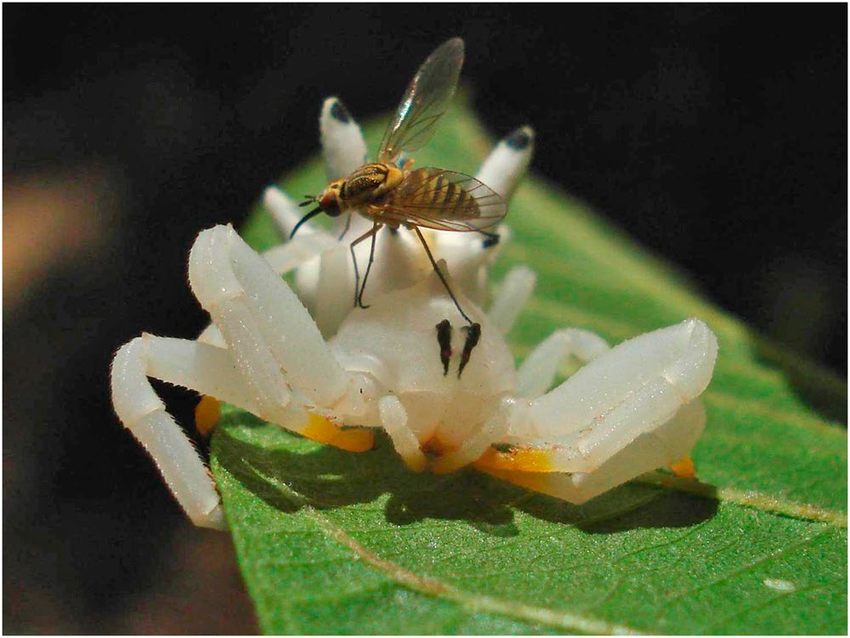In the intricate tapestry of nature’s camouflage, where survival often hinges on blending seamlessly into the environment, a remarkable discovery has emerged from the depths of a Chinese rainforest. Environmental scientists Shi-Mao Wu and Jiang-Yun Gao, from Yunnan University, stumbled upon a mesmerizing display of cooperative mimicry orchestrated by a pair of crab spiders—one male, one female. Their collaborative effort to mimic a flower not only astonished the researchers but also sheds light on the ingenious strategies employed by creatures in the natural world to deceive both prey and predators alike. Published in the journal Frontiers in Ecology and the Environment, this groundbreaking observation marks a paradigm shift in our understanding of mimicry in the animal kingdom.
Unveiling Nature’s Collaboration: As Wu and Gao embarked on their expedition through the lush landscapes of Xishuangbanna, their keen eyes caught sight of a spider meticulously masquerading as a flower. Intrigued by this spectacle, they soon realized that what appeared to be a solitary spider was, in fact, a duo—a male and a female—working in tandem to create the illusion of a blooming blossom. This unprecedented instance of cooperative mimicry represents a novel adaptation in the realm of arachnids, where deception becomes a finely honed art form.
The Ingenious Strategy of Crab Spiders: Belonging to the Thomisidae family, crab spiders have long been revered for their mastery of disguise, camouflaging themselves amidst floral landscapes to evade detection by predators and ensnare unsuspecting prey. Yet, the revelation of cooperative mimicry adds a new dimension to their repertoire of tactics. By assuming complementary roles—a female mirroring the delicate petals of a flower, while a diminutive male mimics the intricate details of a pistil—these spiders achieve a level of mimicry unparalleled in the annals of science.
Unraveling the Evolutionary Enigma: While Wu and Gao’s serendipitous encounter offers a tantalizing glimpse into the world of cooperative mimicry, it also beckons further inquiry into the evolutionary origins of this phenomenon. As scientists delve deeper into the behavioral patterns of crab spiders and explore the intricacies of their genetic makeup, a clearer picture of their evolutionary history begins to emerge. Questions abound: Is this collaborative behavior ubiquitous among crab spider species? What selective pressures drove the development of such elaborate mimicry? Only through meticulous study and analysis can we hope to unlock the mysteries concealed within nature’s enigmatic designs.
Implications for Conservation and Ecology: Beyond its scientific intrigue, the discovery of cooperative mimicry among crab spiders holds profound implications for conservation and ecological management. By unraveling the intricacies of these natural adaptations, researchers gain invaluable insights into the delicate balance of ecosystems and the interconnectedness of species within them. Understanding the mechanisms behind cooperative mimicry empowers conservation efforts, enabling scientists to devise innovative strategies for protecting biodiversity and preserving fragile habitats threatened by human encroachment and environmental degradation.
In the realm of nature’s grand theater, where deception and adaptation reign supreme, the revelation of cooperative mimicry among male and female crab spiders stands as a testament to the ingenuity of life itself. As scientists peer into the intricate web of existence, each discovery unveils a new chapter in the ongoing saga of evolution. Wu and Gao’s groundbreaking observation serves as a beacon of inspiration, igniting a fervent quest for knowledge and a deeper appreciation of the wonders that abound in the natural world. Through collaborative exploration and unwavering curiosity, we continue to unlock the secrets concealed within nature’s labyrinthine tapestry, forever humbled by its boundless complexity and unfathomable beauty.
